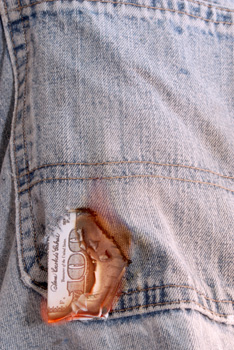 Jan. 10, 2014 – Robert Brown, convicted in 2011 for robbing a bank in Milwaukee, recently lost his federal appeal despite arguing that a detective gave expert testimony concerning “dye packs” but it was improperly allowed as lay testimony.
Jan. 10, 2014 – Robert Brown, convicted in 2011 for robbing a bank in Milwaukee, recently lost his federal appeal despite arguing that a detective gave expert testimony concerning “dye packs” but it was improperly allowed as lay testimony.
As the detective explained, banks hide dye packs among bills in registers, so robbers cannot detect them when stealing money. They detonate a short time after removal from the bank, burning at up to 400 degrees and releasing smoke, tear gas, and dye.
At trial, the alleged getaway driver (who struck a deal with prosecutors) testified that after Brown and another accomplice robbed the Guaranty Bank in Milwaukee, Brown started discarding money from his pockets because his pants essentially caught on fire. Police had recovered dye packs in two locations, consistent with the driver’s testimony.
Bank employees testified that one masked man jumped the counter and removed money from a drawer containing a dye pack among $20 bills.
The government also produced photos of Brown’s leg showing what appeared to be burn marks. Brown, and his witness, said he sustained that injury when a firework hit him at a family picnic. However, the jury went on to convict Brown of bank robbery.
Brown appealed. He argued that his conviction should be vacated because the detective’s testimony about dye packs was expert testimony, but the court allowed it as lay testimony not subject to the same evidence rules.
The detective had testified about dye pack specifications and how they work. He also said he personally observed several situations in which dye packs caused burn injuries to bank robbery suspects who had stuffed them in their clothing pockets.
In U.S. v. Brown, No. 12-1695 (Jan. 9, 2014), a three-judge panel for the U.S. Court of Appeals for the Seventh Circuit ruled the detective’s testimony was a “mixed bag” of lay and expert testimony. However, the panel upheld the conviction because Brown could not demonstrate “that he would not have been convicted absent the error.”
The panel said the detective’s testimony about dye pack specifications was “specialized knowledge,” but allowing such evidence under lay evidence rules was harmless.
“[N]one of that evidence was damaging to Brown, and certainly none of it was so damaging as to constitute error that is plain and that resulted in a miscarriage of justice,” wrote Judge Ilana Rovner for the three-judge panel.
The panel also rejected Brown’s argument that the jury instructions were flawed because, although defendants who aid and abet crimes may be guilty to the same extent as the principal, he did not knowingly aid and abet the use of a firearm.
“[T]he firearm was brandished by the other perpetrator immediately upon entering the bank, and was visibly used throughout the robbery,” Rovner wrote. “[T]here is no basis whatsoever for any argument that the co-perpetrator lacked knowledge of the firearm.”
